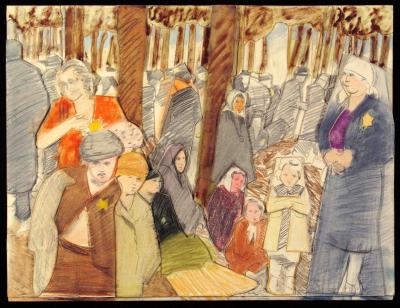Larry Rivers’s Jewish Themes on View in Sag Harbor

Larry Rivers was a remarkably prolific and protean artist, not to mention an accomplished jazz musician, poet, actor, filmmaker, writer, and teacher. His curiosity was boundless, and the provocative and often humorous nature of his art belied the seriousness of his commitment to research.
A new exhibition at Temple Adas Israel, set to open Sunday with a reception from 5 to 7 p.m., will focus on Rivers’s works with Jewish themes. According to Mindy Cantor, who organized the show with Ann Chwatsky, “Larry had been involved with Jewish life and culture for most of his life.”
Some of his works were autobiographical, among them “Wedding Photo,” a painting that Ms. Cantor said was probably inspired by his sister’s wedding. Another work, “Burial Study V,” which captured his grandmother’s funeral, was inspired by Courbet’s painting “Burial at Orleans.” Rivers often drew from history and art history.
Five works concerning the Holocaust will be on view. Among them is “Four Seasons: Fall in the Forest of Birkenau,” which was derived from a photograph of Hungarian Jews waiting in a birch tree grove, the gas chambers visible behind them.
Felix Nussbaum, a German Jew, many of whose paintings documented the Holocaust, painted “Self-Portrait With Jewish Identity Card” in 1943. According to Ms. Cantor, “Rivers made the same portrait, wearing what Nussbaum is wearing and casting himself like Nussbaum, with the yellow Star of David on his raincoat and an identity card in his hand.”
“Kosher Ford,” a lithograph of a Ford truck and a sign that says kosher in Hebrew, reflects the element of Pop that was often combined in his work with decidedly non-Pop stylistic elements. It was also a pun on kosher food and Ford and “brings together high and low culture and commerce,” Ms. Cantor said.
A drawing titled “Hester Street” is a large triptych depicting the history of the Jews from Moses to Jewish immigrants coming to America, with matzah serving as a symbol of Jews’ freedom from slavery.
“I knew Larry many years ago,” said Ms. Chwatsky, “when I was the director of the Master Arts program in Southampton. I used to bring students to his studio. He was very generous with his time, and it was the most exciting thing that happened to the students that summer.”
Ms. Chwatsky recalled that on the occasion of the temple’s 100th anniversary one of the members asked Rivers to draw a portrait of the rabbi at the podium. “He came a couple of times to get the feel of it. He really got interested in it and did a beautiful drawing of the rabbi that has been at the temple ever since.”
The show will include in-depth information panels, written by Ms. Cantor, for each piece. All the work on view is on loan from the Larry Rivers Foundation, whose executive director, David Joel, worked closely with the curators.
Both Mr. Joel and Helen Harrison, director of the Pollock-Krasner House and Study Center, will speak about Rivers on dates to be announced. The exhibition will run through Sept. 6.
